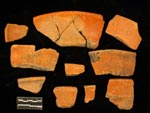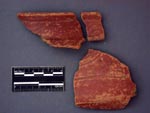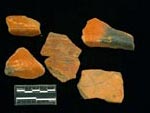
| FAMSI © 2004: Arturo René Muñoz |
||||||||||||||||||||||||||||||||||||||||||||||||
|
The Ceramic Sequence of Piedras Negras, Guatemala: Type and Varieties The Hol Ceramic Phase (500 B.C.–300 B.C.) The Hol ceramic complex represents the first major occupation of Piedras Negras. Based on comparisons with other sites, we estimate this phase to last from about 500 B.C. to approximately 300 B.C. In almost all respects, the Middle Preclassic ceramics of Piedras Negras resemble contemporary materials from elsewhere in the Petén. If any major differences can be noted between the Middle Preclassic assemblage of Piedras Negras and those of other sites, it may be visible in lack of variety in vessel forms, though this may be related to sample size. Hol ceramics were found in seven locations at Piedras Negras, all in the southern sector of the site. Almost all Hol ceramics have been found in construction fill mixed with later Preclassic materials, though the lowest levels of a midden found in front of Str. R-5 consisted exclusively of Middle Preclassic ceramics. The total sample of diagnostic Hol ceramic material is small and fragmented, containing only about 350 diagnostic sherds. For this reason it is difficult to describe the complete range of forms represented. The most common forms appear to be thick-walled bowls or plates with divergent to out-curving walls, slipped jars with short, nearly vertical necks, and dishes with thickened direct, or thickened everted rims. Slips tend to thick and waxy, with fire-clouding and crazing common. Red monochromes dominate the assemblage with both cream and black making up a smaller percentage of the assemblage. In general, incising, fluting, and gadrooning are the most common decorative modes. Resist decoration (Tierra Mojada Resist) is also known from Hol complex assemblages but is infrequent. Parallel rows of incised lines on the interior of plate rims are the most common decorative motif. Gadrooning or fluting on the exteriors of bowls is also common. The majority of all decorated vessels belong to the Joventud ceramic group. Cream and black monochrome vessels tend to be undecorated. Don Forsythe (personal communication 1999) has noted the Piedras Negras Middle Preclassic ceramics seem to be more heavily constructed than Middle Preclassic sites from elsewhere in the Petén.
|
||||||||||||||||||||||||||||||||||||||||||||||||
|
Text links to all pages at this site are available at the FAMSI INDEX |
||||||||||||||||||||||||||||||||||||||||||||||||


